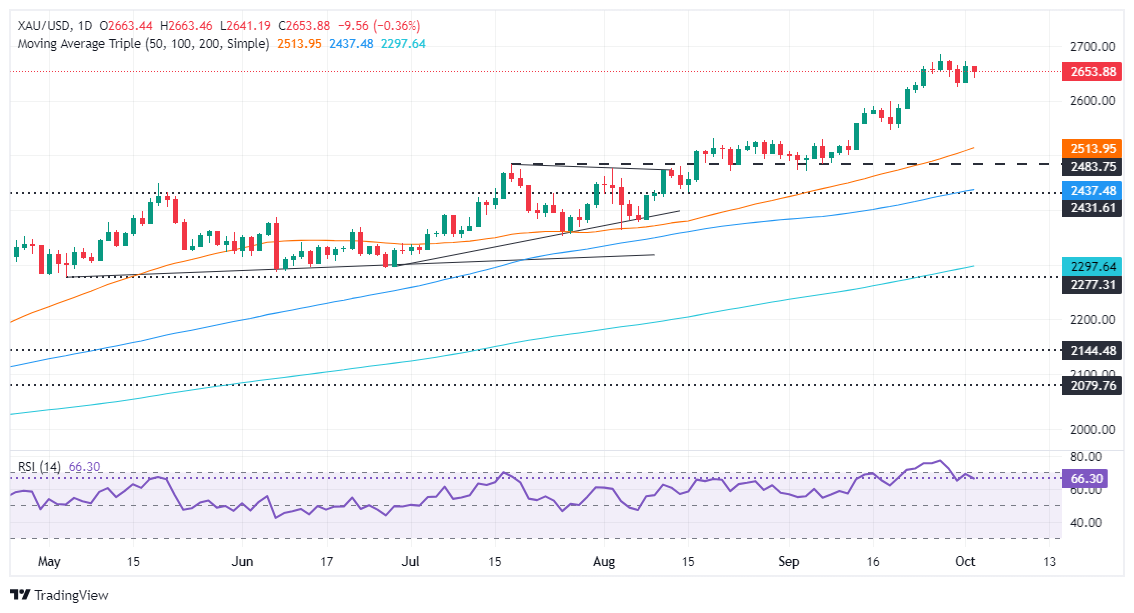Gold falls amid high US yields as Israel weighs retaliatory actions

- Gold price slumps on Wednesday amid heightened tensions between Israel and Iran.
- A robust ADP National Employment Change report could be a prelude to an upbeat NFP.
- Nonfarm Payrolls data on Friday is expected to show 140K new US jobs in September.
Gold retreated on Wednesday during the North American session and dropped 0.50% daily as traders eyed Israel’s reaction to Iran’s attack on Tuesday. Geopolitics remains the driver for traders, which lifted Gold prices after posting back-to-back bearish sessions since last Friday. At the time of writing, the XAU/USD trades at $2,648 after hitting a high of $2,663.
The market mood remains downbeat, as portrayed by US equities trading in the red. According to different newswires, developments in the Middle East suggest an escalation is likely. This indicates that Bullion prices could extend their gains in the short term.
Israel’s envoy to the United Nations commented that Iran will face consequences for its missile attack on Tuesday. At the same time, US Deputy Secretary of State Kurt Campbell added that it is “not just Israel that is thinking about response options to Iran attack, US is too.”
In addition, private hiring in the United States (US) increased above estimates in September, according to ADP National Employment Change data. Meanwhile, Richmond Fed President Thomas Barkin said the 50-basis-point (bps) rate cut in September acknowledged that rates were “out of sync.”
Barkin added that some aspects of the economy suggest the disinflation process would continue but that “it remains difficult to say that the inflation battle has yet been won.”
The non-yielding metal added to gains after the Fed decided to lower the fed funds rate at the September meeting. Nevertheless, higher US Treasury yields and a stronger US Dollar during the day are headwinds for the precious metal.
The US 10-year Treasury note yields 3.783%, up five basis points. At the same time, the US Dollar Index (DXY), which tracks the buck’s performance against a basket of six peers, gains 0.39%, up at 101.60.
Ahead of the week, investors are tracking further US jobs data. On Friday, Nonfarm Payrolls figures are expected to show the economy added 140K people to the workforce in September, less than the 142K jobs created in August, while the unemployment rate is foreseen remaining unchanged.
Daily digest market movers: Gold price retreats amid Mideast war
- The ADP National Employment Change for September came in at 143K, up from the upwardly revised 103K the previous month and surpassing forecasts of 120K.
- August Job Openings & Labor Turnover Survey (JOLTS) improved, exceeding estimates and tempering woes of the labor market.
- Nevertheless, business activity in the manufacturing sector measured by the ISM Manufacturing PMI for September remained steady at 47.2, unchanged from the previous reading, but fell short of estimates of 47.5.
- Market participants have placed the odds of a 25 bps Fed rate cut at 63.8%, while the chances for a larger 50 bps cut have diminished to 36.2%, according to the CME FedWatch Tool.
XAU/USD technical analysis: Gold price creeps lower but stays above $2,650
Gold price is upwardly biased despite losing some steam as traders book profits, awaiting the next phase of the conflict. Momentum remains bullish as depicted by the Relative Strength Index (RSI) but is exiting from overbought conditions, sparking the retracement.
If XAU/USD drops below $2,650, this would open the door to test the September 30 daily low of $2,624, followed by the September 18 peak at $2,600. A breach of the latter will expose the 50-day Simple Moving Average (SMA) at $2,513.
On further strength, if it clears the all-time high of $2,685, it could extend its gains to $2,700.
Risk sentiment FAQs
In the world of financial jargon the two widely used terms “risk-on” and “risk off” refer to the level of risk that investors are willing to stomach during the period referenced. In a “risk-on” market, investors are optimistic about the future and more willing to buy risky assets. In a “risk-off” market investors start to ‘play it safe’ because they are worried about the future, and therefore buy less risky assets that are more certain of bringing a return, even if it is relatively modest.
Typically, during periods of “risk-on”, stock markets will rise, most commodities – except Gold – will also gain in value, since they benefit from a positive growth outlook. The currencies of nations that are heavy commodity exporters strengthen because of increased demand, and Cryptocurrencies rise. In a “risk-off” market, Bonds go up – especially major government Bonds – Gold shines, and safe-haven currencies such as the Japanese Yen, Swiss Franc and US Dollar all benefit.
The Australian Dollar (AUD), the Canadian Dollar (CAD), the New Zealand Dollar (NZD) and minor FX like the Ruble (RUB) and the South African Rand (ZAR), all tend to rise in markets that are “risk-on”. This is because the economies of these currencies are heavily reliant on commodity exports for growth, and commodities tend to rise in price during risk-on periods. This is because investors foresee greater demand for raw materials in the future due to heightened economic activity.
The major currencies that tend to rise during periods of “risk-off” are the US Dollar (USD), the Japanese Yen (JPY) and the Swiss Franc (CHF). The US Dollar, because it is the world’s reserve currency, and because in times of crisis investors buy US government debt, which is seen as safe because the largest economy in the world is unlikely to default. The Yen, from increased demand for Japanese government bonds, because a high proportion are held by domestic investors who are unlikely to dump them – even in a crisis. The Swiss Franc, because strict Swiss banking laws offer investors enhanced capital protection.
